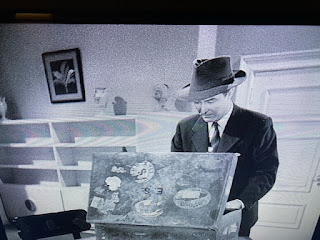Fritz Lang's 1944 noir "Ministry of Fear" is wonderfully cynical yet weirdly (studio note?) hopeful. For a Noir. Melodramatic, sure....please don't tone down that melodrama. The picture involves a Nazi cabal existing, and hiding, in plain sight during the height of the London blitz. Ray Milland ("Dial M for Murder") stars as Stephen Neale, a lost soul who, as the picture opens, is counting down the minutes until he's let out of an insane asylum in Lembridge, England, a facility where he was remanded for the past two years for the assisted suicide of his ailing wife. On his way back to London, Neale stops at the Lembridge Fair where he pays a shilling to guess the weight of a cake. He's off, thinks nothing of it, stops in the Palmistry tent and is told by Madame Bellane to guess again! Weird but ok. He does, he wins, and that cake is the MacGuffin that sets this plot in motion. Is it a MacGuffin? What's in the cake? Neale heads for the train to London only to be stopped by some carny telling him someone actually outguessed him, that someone being the Aryan looking fellow back by the tent. Neale uses some deft sleight of wordplay to hold onto the cake and board the train....followed closely by a blind man. A Luftwaffe raid later and the blind man is blown up along with the cake. Neale thinking, what the fuck was all that?
The plot unfolds like many war-centered Noirs, with an unfurling cast of characters, some Nazis, with hidden motives like Carla (Marjorie Reynolds) and her brother Willi (Carl Esmond), two Austrian refugees who at first glance, seem a bit....neat? Carla falls for Neale, of course, and the feeling appears mutual. The brother-sister team run the charitable organization (Mothers of Free Nations) that raffled off the cake. There's Inspector Prentice (Percy Waram) who is more than accommodating considering what must appear as wild claims by Neale. The picture, released during the war, post-Blitz by just a few years, must have rattled some audiences. In particular, I'm thinking of the scene where the sirens wail and Neale and Carla, along with hundreds more Londoners, head into The Underground to wait out the bombing that may or may not end their lives, the horrific becoming the routine. The horrific eliciting declarations of love.


No comments:
Post a Comment